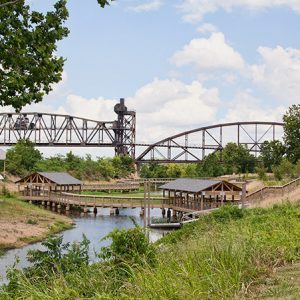calsfoundation@cals.org
Rock Island Bridge (Little Rock–North Little Rock)
aka: Choctaw Bridge
aka: Clinton Presidential Park Bridge
The Rock Island Bridge is a lift-span bridge crossing the Arkansas River between downtown Little Rock (Pulaski County) and North Little Rock (Pulaski County). One of six bridges linking the two downtowns, the Rock Island Bridge was originally constructed as a railroad bridge in 1899; it was converted to serve as a pedestrian bridge in 2011 to complement the William J. Clinton Presidential Center and Park.
In late 1898, the Choctaw and Memphis Railroad was organized with the goal of establishing a railroad into the Indian Territory (modern-day Oklahoma). Congress passed legislation authorizing construction of a new bridge across the Arkansas River in January 1899, and the Little Rock Bridge Company formed that May to develop plans for constructing the new railroad bridge. McGee, Kahmann & Company of Kansas City, Missouri, received the contract for the bridge, which would be downstream from the existing Baring Cross and Junction bridges. Railroad officials voted to name the new structure the Choctaw Bridge.
Construction of the new bridge took place remarkably quickly. The first wooden caissons, using 900,000 board feet of lumber, were installed on September 25, 1899, and filled with 5,000 cubic feet of concrete to create the structure’s piers. Each of the four steel bow-truss spans was 400 feet long and weighed 1,247,740 pounds, while the swing span, which could make a complete revolution in ninety seconds, weighed 1,070,534 pounds. The first train to cross the span was Choctaw and Memphis engine no. 11 on November 14, 1899. The bridge was completed by December 1899, with the Little Rock Board of Trade hosting a banquet on the milestone on December 5 and the first through train leaving the capital for Weatherford, Oklahoma, at 4:37 a.m. on December 10.
The Choctaw and Memphis eventually became part of the Chicago, Rock Island and Pacific Railroad, at which time the bridge became known as the Rock Island Bridge. When the McClellan-Kerr Arkansas River Navigation System was undertaken, the original swing span had to be replaced with a lift span, which was accomplished in the 1960s. After the Rock Island Railroad declared bankruptcy and was dissolved, the Missouri Pacific Railroad acquired the bridge, and the Union Pacific Railroad took ownership in 1983 when it bought the Missouri Pacific line. That railroad discontinued use of the structure, leaving the center span raised and cutting off power to it.
In June 1995, the Union Pacific announced plans to remove the lift span of the Rock Island Bridge and demolish the rest but reversed course that November in the face of opposition by Pulaski County, North Little Rock, and Little Rock, which hoped to renovate the structure as a pedestrian bridge. That hope gained ground in the spring of 2010 when ground was broken in late May to convert the old railroad bridge into the Clinton Presidential Park Bridge. The project cost $10.5 million in federal and local funds, augmented by donations, and former President Bill Clinton dedicated the revamped bridge and adjoining William E. Clark Wetlands on September 30, 2011, before a crowd of 1,750. The bridge serves as the eastern terminus of the Arkansas River Trail.
For additional information:
Hull, Clifton E. “The City of Little Rock Is Truly a City of Bridges.” Arkansas Gazette, July 2, 1972, p. 4E and 6E.
McDade, Bryan. “The Six Bridges at Little Rock: Understanding the Historical Significance and Relevance of the Six Bridges that Span the Arkansas River at Little Rock.” MA thesis, University of Arkansas at Little Rock, 2004.
Netterson, Kristin. “Clinton: Let Span Represent Harmony.” Arkansas Democrat-Gazette, October 1, 2011, pp. 1B, 10B.
———. “Clinton Park Bridge Nears Debut.” Arkansas Democrat-Gazette, September 26, 2011, pp. 1B, 3B.
Pierce, Ray. “Rock Island Span.” Arkansas Democrat-Gazette, November 10, 1995, p. 2B.
Mark K. Christ
Central Arkansas Library System
 Post-Reconstruction through the Gilded Age, 1875 through 1900
Post-Reconstruction through the Gilded Age, 1875 through 1900 Transportation
Transportation Choctaw Bridge
Choctaw Bridge  Clinton Library
Clinton Library  Presidential Park Wetlands
Presidential Park Wetlands  Rock Island Bridge
Rock Island Bridge 



Comments
No comments on this entry yet.